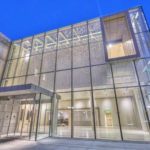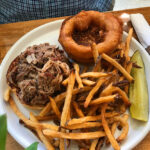Jason Sandford
Jason Sandford is a reporter, writer, blogger and photographer interested in all things Asheville.
 By Cliff Mori
By Cliff Mori
Wicked Weed recently opened its Funkatorium, a second downtown location that is focused on sour and barrel aged beers. Since it is separately licensed, one can argue that it became the ninth downtown brewery and the 13th or 14th in Asheville (that also depends on how you draw the lines). Either way, it added to the perception that there is a TON of beer being produced downtown. Every time a new brewery opens, the questions of sustainability begin: How many breweries can Asheville really support?
I’ve been hearing these questions since Pisgah Brewing opened as the fifth brewery in greater Asheville. Our city has fewer than 90,000 residents. One has to imagine at least some of them are under the age of 21, and some of the rest don’t drink beer. How many breweries can the remainder support? So far, it seems like 13 is safe, though Catawba Brewing and the owners of Troy and Sons are hoping there is room for at least two more.
Beer Tourists
Like many other local industries, a lot of the beer being produced goes to visitors of Asheville. While locals certainly enjoy a substantial amount, there’s just too much being made to rely on Asheville-based consumption alone. Over the past few years, titles like “Beer City” and expansion announcements from big players like Sierra Nevada, Oskar Blues and New Belgium have led to increasing numbers of Beer Tourists coming to Asheville just to drink beer. Once those big guys finish opening their doors to the public, the city estimates that an additional 1 million visitors will come to Asheville each year just for beer.
Wider Distribution
While that is great news for the breweries and great for the servers and bartenders working in the tasting rooms, there are farther reaching benefits of Beer Tourists. We sometimes forget that many of our local breweries don’t distribute their wares outside of the local area. All of this tourism attention should lead to a wider audience for distribution. The expectation is that those visitors will return home and start asking their bar owners, distributors, etc., about getting some of the beers they had while they were here. Both tourism and wider distribution help build the Asheville brand and will make it easier for other breweries to grow.
While all of this sounds like plausible speculation, how are the breweries doing today, crammed together in a tiny mountain town with not enough locals to support them? Surprisingly well, actually. I reached out to a number of Asheville breweries to find out how business is going. Some of the answers were surprising. Here’s a breakdown of announced expansions:
The Old Guard
Highland Brewing, the brewery who started it all here in Asheville back in 1994, continues to be Asheville’s largest locally owned brewery. A new 30,000 sq. ft. expansion and faster bottling line will bump Highland’s production from 40,000 barrels (BBLs) this year up to a potential 100,000 BBLs according to an article by brewbound.com. Last year, Asheville’s original brewery produced roughly 35,000 barrels. Highland’s beer is currently sold in nine states.
Green Man Brewing, in business since 1997, produced 5,000 barrels of beer last year. They are on pace to produce over 8,000 this year. This continues their 50 percent growth for each of the last five years. A huge boost from a new production facility currently under construction will bring output to 17,000-18,000 barrels by the end of 2015. Green Man is available throughout North Carolina and has ventured into surrounding states over the past two years. The expansion will help Green Man expand into new markets.
And it isn’t just the older breweries that are gaining ground. Asheville branded beer seems to have hit a critical mass that is presenting fast growth opportunities for newer breweries as well.
The Class of 2013
Burial Beer, currently Asheville’s smallest brewery, produced 150 barrels of beer from their tiny 31 gallon set-up last year. The brewery recently purchased a much larger 10 barrel system and expects production to jump to 1,000 barrels this year. A lot of that will be sold at their expanded tasting room and urban farm on Collier, but some will find its way into cans and kegs for sale at bottle shops and bars around town.
Hi-Wire Brewing, winner of best new N.C. brewery of the year last year, has flipped the traditional small brewery business model on its head and is growing by leaps and bounds as a result. First year production was supposed to be 800 barrels, but instead reached 1,800 due to the success of their 12oz bottles being sold throughout North Carolina. An expansion earlier this year will bring the brewery to 3,500 BBLs and another expansion before the end of the year will lead to roughly 7,000 barrels produced next year. For now, that beer will stay in North Carolina, but further expansion plans could lead to out of state distribution.
Wicked Weed Brewing, which technically opened on December 28, 2012, continues to gain national attention as one of the best up and coming breweries in the US. Back to back gold medal wins at GABF and an unending desire to put out unique beers, has kept their Biltmore Avenue tasting room packed since day one. The brewery expected to produce 1,200 BBLs their first year, but instead put out 2,800. This year they are on track to sell nearly 5,000.
The Funkatorium, a small tasting room attached to a warehouse full of sour and other barrel aged beers, opened recently on Coxe Avenue to help spread out the crowds. Also in the works is a production facility in Enka that will allow a combined pace of 9,000 barrels a year by the end of 2015. The bigger facility will allow canning and bottling of Wicked Weed’s flagship beers which will be sold throughout North Carolina, at least initially.
The Newest Members
Twin Leaf Brewing, barely six months in business, has seen steady increases in production since their opening last March. On track to exceed their first year estimate of 700 barrels, the brewery is beginning to sell kegs to bars and restaurants around town. Tasting room business continues to grow and plans for next year include an outdoor beer garden to help meet customer demand in the booming South Slope neighborhood.
Thirsty Monk Pub and Brewery took a hiatus from brewing last year but recently built a larger brewery to increase overall production from 60 barrels a year to roughly 300. For now, Thirsty Monk beers will be sold primarily at their Biltmore Park and Reynolds Village locations, though future plans include a production facility on Thompson Street in Oakley that will allow for 2,500 barrels each year. An official groundbreaking hasn’t been set, but an announcement should be coming soon.
Just from those breweries alone there will be an ADDITIONAL 17,000 barrels of beer made in Asheville next year. That’s 527,000 gallons! That doesn’t include growth from the other half dozen amazing Asheville breweries not included in this article. So, for now it seems there’s plenty to go around. And if there is a saturation point, we are nowhere near it. National interest in craft beer continues to grow, and the Asheville brand is seen as a sign of quality in an ever more crowded beer marketplace. I will do my best to follow up with these breweries next year to see if these expansion bets paid off, but there’s no arguing that it is an exciting time for Asheville beer.
Cliff Mori is the owner and operator of BREW-ed, which offers brewery tours and a variety of beer training in Asheville. He was the first Certified Cicerone in Western North Carolina (the beer equivalent to the wine world’s sommelier), then began working for the Cicerone Certification Program by traveling around the U.S. proctoring exams. Cliff also teaches a variety of beer-related courses at Asheville-Buncombe Technical Community College.




























One World Brewing has been open about 5 months. They’re in a speak-easy like setting downstairs from Farm Burger. They have a very small brewing set up and pretty much sell all they make right there in the tap room. The entrance is via the alley next to Salsa’s. I think they only put a sign out when they’re open.